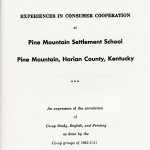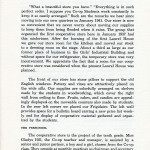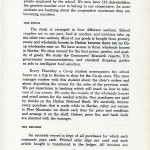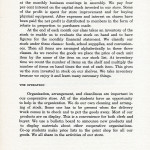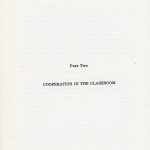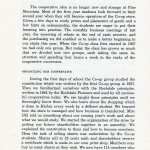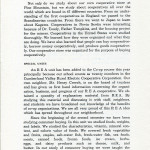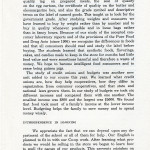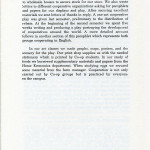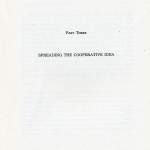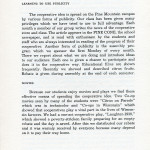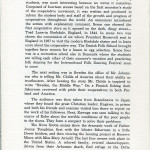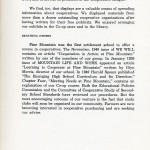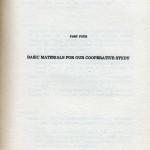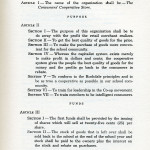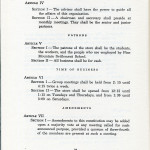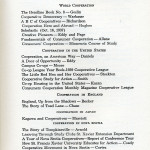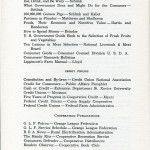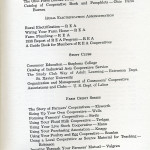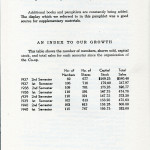Pine Mountain Settlement School
Series 17: PUBLICATIONS PMSS
Experiences in Consumer Education
“Experiences in Consumer Cooperation”
Report 1940-1941
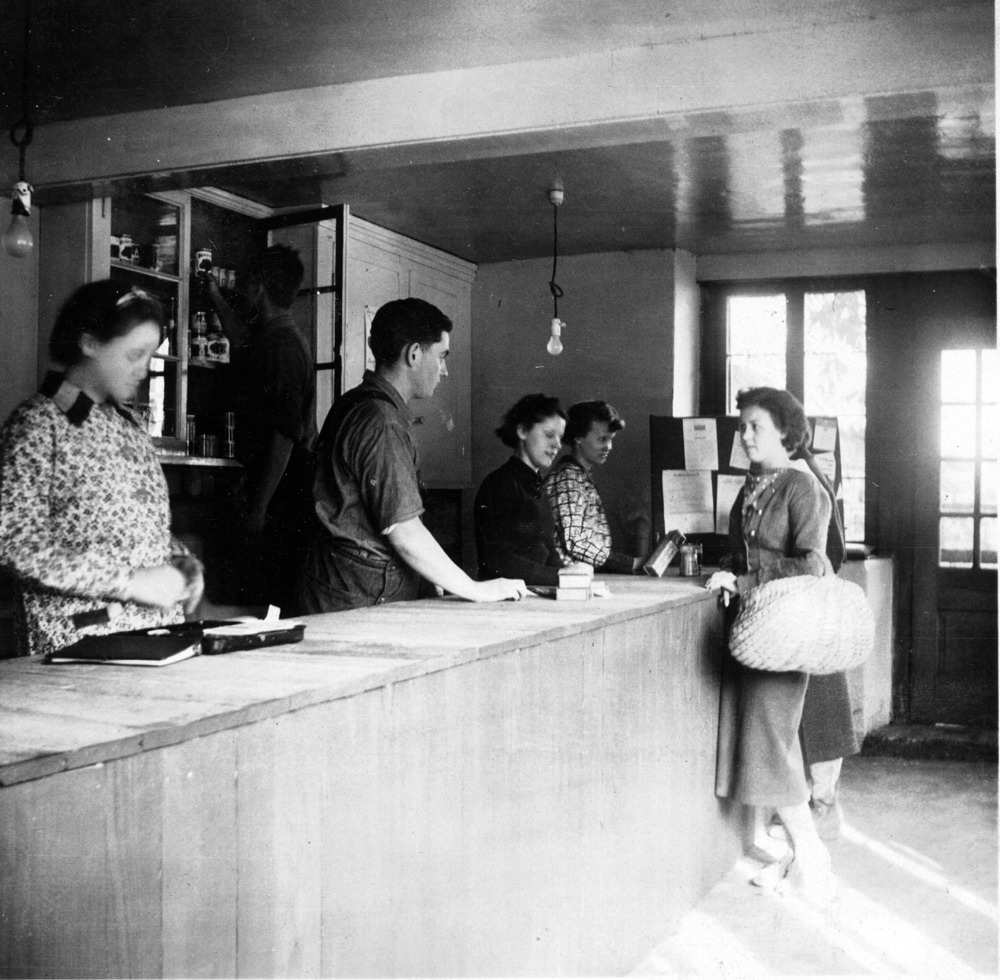 Girl’s Industrial. Interior view of Co-op Store, c. 1940s. [II_6_swimming_draper_boys_263a.jpg]
Girl’s Industrial. Interior view of Co-op Store, c. 1940s. [II_6_swimming_draper_boys_263a.jpg]
TAGS: Experiences in Consumer Education 1940-1941, consumer cooperatives, Gladys Hill, Consumers’ Research reports, U.S. government recommendations, salesmanship, Co-op Constitution, Rochdale principles, Rural Electrical Cooperative (REA), U.S. Bureau of Agricultural Economics, Pure Food and Drug Acts, credit unions, interdependence in learning, co-op movies and plays, study clubs, co-op library, growth index
Experiences in Consumer Education 1940-1941
“Experiences in Consumer Cooperation” is a report by Co-op students on their studies and operation of Cooperative program at Pine Mountain Settlement School during the period of the school year 1940-1941. The subtitle of the report, “An expression of the correlation of Co-op Study, English, and Printing as done by the Co-op groups of 1940-1941,” reflects the goal of the program, interdependence in learning.
The central feature of the program was a cooperative store run by tenth-grade students. Miss Gladys Hill, the Co-op teacher and manager, was assisted by a senior and junior partner, a boy and a girl, chosen from the Co-op class. They presided at monthly meetings as chairman and secretary.
TRANSCRIPTION: Experiences in Consumer Education 1940-1941
[pages 1 & 2]
EXPERIENCES IN CONSUMER COOPERATION
at
Pine Mountain Settlement School Pine Mountain,
Harlan County, Kentucky
An expression of the correlation
of
Co-op Study, English, and Printing
as done by the Co-op groups of 1940-1941
[page 3]
Part One
COOPERATION IN THE STORE
[page 04] COOPERATION IN THE STORE
THE STORE
“What a beautiful store you have.” “Everything is in such perfect order. I suppose you Co-op Students work constantly to keep it so neatly arranged.” Such are the remarks we hear since moving into our new quarters in January 1941. Our store is now so convenient that we never worry about moving our supplies to keep them from being flooded when it rains. The group that organized the first cooperative store here in January 1937 had this misfortune. After the burning of the first Laurel House [I], we gave our store room for the kitchen and moved our stock to a dressing room on the stage. About a third as large as our former place of business in the Girls’ Industrial Building and without space for our refrigerator, the temporary store was very inconvenient. We appreciate the fact that a room for our cooperative store was considered when the present Laurel House [II] was planned.
The front of our store has stone pillars to support the old English windows. Pottery and vines are attractively placed on the wide sills. Our supplies are colorfully arranged on shelves made by the students in woodworking, which cover the right wall from ceiling to floor. Fruits, cakes, and candies are appealingly displayed on the movable counters also made by students. In the rear left corner we placed our Frigidaire. The left wall provides space for a bulletin board bearing a new price list weekly and for display of cooperative material gathered and organized by the students.
THE PERSONNEL
The cooperative store is the project of the tenth grade. Miss Gladys Hill, the Co-op teacher and manager, is assisted by a senior and junior partner, a boy and a girl, chosen from the Co-op class. They preside at monthly meetings as chairman and secretary.
[page 5]
respectively. They also sign the certificates of the shareholders. The secretary keeps the minutes of every meeting. The members of the consumers’ cooperative are the student, staff, and other people employed by the school. We now have 115 shareholders, the greatest number ever to belong to our cooperative. As more students are learning about the cooperative movement they are becoming members.
THE STOCK
The stock is arranged in four different sections. School supplies are in one part, food in another, and toiletries take up the other two sections. Most of our goods [are] bought from grocery stores and wholesale houses in Harlan because there are no Coop wholesales near us. We have access to three wholesale houses in Harlan. We shop around for the best prices, grades, and quality of goods. We study the Consumers’ Research reports, U.S. government recommendations, and standard shopping guides as aids to intelligent food selection.
Every Thursday a Co-op student accompanies the school buyer on a trip to Harlan to shop for the Co-op store. The store manager confers with this student about the store’s orders and about depositing the money for the sales of the previous week. We get experience in banking which will teach us how to take care of our money. We make the rounds of the wholesale houses and retail stores for the needed articles. Our purchases are paid by checks on the Harlan National Bank. We carefully itemize every purchase that is made while in Harlan. After our return to Pine Mountain we check each item for price and condition and arrange it on the shelf. Orders, price list, and bank book are checked with the manager.
THE RECORDS
An accurate record is kept of all purchases for which each consumer pays cash. Printed sales slips are used and each article bought is transferred to the ledger. All invoices are
[page 6]
filed in order and the unit cost of each article is recorded as it is purchased. Each month an inventory is taken to get the value of all stock on hand. A weekly deposit is made at the bank and we keep an accurate record of our checking account which is read at the monthly business meetings in assembly. We pay four per cent interest on the capital stock invested in our store. Some of the profit is spent for store improvement and for buying physical equipment. After expenses and interest on shares have been paid the net profit is distributed to members in the form of rebate in proportion to purchases made.
At the end of each month our class takes an inventory of the stock to enable us to evaluate the stock on hand and to have figures for the monthly financial statement. We classify our stock under three classes: foods, school supplies, and conveniences. Then all items are arranged alphabetically in these three classes. As we receive the goods we place the price of each unit item by the name of the item on our stock list. At inventory time we count the number of items on the shelf and multiply the number of items on hand times the cost of each item. This gives us the sum invested in stock on our shelves. We take inventory because we enjoy it and learn many necessary things.
THE OPERATION
Organization, arrangement, and cleanliness are important in our cooperative store. All of the students have an opportunity to help in the organization. We do our own cleaning and arranging of stock. Someone has to be present when the delivery truck comes in to check and to put the goods away. Most of our products are on display. This is a convenience for both clerk and buyer. We use a bulletin board to announce new products and to display materials about other cooperative organizations. Co-op students make price lists in the print shop for all our goods. We all share in the activities of our store.
[page 7]
Part Two
COOPERATION IN THE CLASSROOM
[page 8]
COOPERATION IN THE CLASSROOM
PRELIMINARIES
The cooperative idea is no longer new and strange at Pine Mountain. Most of the first year students look forward to their second year when they will become operators of the Co-op store. Given a few days to study prices and placement of goods and a few hints on salesmanship, the students are eager to put their learning into practice. The monthly business meetings of last year, the receiving of rebate at the end of each semester, and the purchasing we did, enabled us to make a better beginning in our study this year. When the Co-op class first started in 1937 we had only one group. But today the class has grown so much that we divided into two groups, each taking the same instruction and spending four hours a week in the study of the cooperative movement.
ORGANIZING OUR COOPERATIVE
During the first days of school the Co-op group studied the constitution which was written by the first Co-op group in 1937. Then we familiarized ourselves with the Rochdale principles, written in 1844 by the Rochdale Pioneers and used by all successful cooperatives today. We are taught these principles until we thoroughly know them. We also learn about the shopping which is done in Harlan every week by a different student. We learned how the store is managed and how business is transferred. Miss Hill told us something about our coming year’s work and about what we would study. We started the organization of the store by getting our future shareholders together in an assembly. We explained the constitution to them and how to become members. Then the task of selling shares was undertaken by the Co-op students. Shares sell at 25 cents each and shareholders receive a certificate which is made in our own print shop. Members may buy as many shares as they wish. We now have 115 members who receive rebate at the end of each semester. Students and staff
[page 9]
are eager to buy shares because they know it pays them to be members of the cooperative.
Not only do we study about our own cooperative store at Pine Mountain, but we study about cooperatives all over the world which are found in 47 different countries. From an understanding of the first cooperatives in England we passed to the Scandinavian countries. From there we went to Japan to learn about Kagawa. Cooperatives in Novia Scotia were interesting because of Dr. Coady, Father Tompkins, and the housing project for the miners. Cooperatives in the United States were studied thoroughly. We learned how they were organized and what they are doing. We have also learned that people can buy cooperatively, borrow money cooperatively, and produce goods cooperatively. Our cooperative store was organized for the purpose of buying cooperatively.
SPECIAL UNITS
An R E A unit has been added to the Co-op course this year principally because our school counts as twenty members in the Cumberland Valley Rural Electric Cooperative Corporation. Our own neighbor, Mr. Henry Creech, is on the board of trustees and has given us first hand information concerning the organization, business, and progress of our R E A cooperative. We obtained a quantity of explanatory material from R E A. By studying this material and discussing it with staff, neighbors, and students we have broadened our knowledge of the benefits of co-op organizations. We are all very proud of this R E A idea which has spread throughout our neighborhood.
Since the beginning of the second semester we have been studying consumer buying. In this unit we studied foods, weights, and labels. We studied the characteristics, vitamin, mineral content, and caloric value of foods. We covered fresh vegetables and fruits, staples, salt-water fish, fresh-water fish, sea foods, meats, canned foods, frozen foods, ice cream, herbs, eggs, and dairy products such as cheese, milk, and butter. In our study of consumer buying we were taught the
[page 10]
various standards formulated by the U.S. Bureau of Agricultural Economics such as food stamps on the meat carcass, the quality tag on prepared meats, the seal of quality on the egg cartons, the certificate of quality on the butter and oleomargerine box, and also the grade symbol and descriptive terms on the label of canned goods. This taught us to look for the government grade. After studying weights and measures we have learned to buy by weight rather than by number and to buy in quality whenever possible and in loose bags rather than in fancy boxes. Because of our study of the accepted consumer laboratory reports and of the provisions of the Pure Food and Drug Acts (since 1906) we recognize the differences in foods and that all consumers should read and study the label before buying. The students learned that synthetic foods, flavorings, cakes, and candies made to keep in the store for months had little food value and were sometimes harmful and therefore a waste of money. We hope to become intelligent food consumers and to cease being guinea pigs.
The study of credit unions and budgets was another new unit added to our course this year. We learned what credit unions are, how they help cooperatives, how they differ in organization from consumer cooperatives, and that state and national laws govern them. In our study of budgets we took six different incomes and compared them with one another. The smallest income was $800 and the largest was $5000. We found that food took most of a family’s income at the lower income level. Budgeting helps the family to save money and to spend money wisely.
INTERDEPENDENCE IN LEARNING
We appreciate the fact that we can depend upon any department of the school or all of them for help. Our English is planned to fit in with our Co-op work. After learning what products we would be selling in the store we began to learn how to spell the names of our products. This prevents mistakes on sales slips. We also organized and checked our Co-op notebooks.
[page 11]
Those participating in the monthly meetings rehearse and make improvements in speech and posture. We wrote business letters to wholesale houses to secure stock for our store. We also wrote letters to different cooperative organizations asking for pamphlets and papers for our displays and play. After securing excellent materials we sent letters of thanks in reply. A one-act cooperative play was given last semester, preliminary to the distribution of rebate. At the beginning of the second semester we spent five weeks writing and producing a play portraying the development of cooperatives around the world. A more detailed account follows in another section of this pamphlet which represents both groups cooperating in English.
In our art classes we made graphs, maps, posters, and the scenery for the play. Our print shop supplies us with the needed stationery which is printed by Co-op students. In our study of foods we borrowed supplementary materials and papers from the Home Economics department. When studying eggs we secured some material from the farm manager. Cooperation is not only carried out by Co-op groups but is practiced by everyone on the campus.
[page 12]
Part Three
SPREADING THE COOPERATIVE IDEA
[page 13]
LEARNING TO USE PUBLICITY
The cooperative idea is spread on the Pine Mountain campus by various forms of publicity. Our class has been given many privileges which we have tried to use to full advantage. Each month a member of our group writes the news of the cooperative store and class. The article appears in the PINE CONE, the school newspaper, and is read with enthusiasm by the students and staff who are always interested in reading of the progress of their cooperative. Another form of publicity is the assembly program which we sponsor the first Monday of every month. There we report about what we are doing and introduce ideas to our audience. Each one is given a chance to participate and does it in the cooperative way. Educational films are shown frequently. Recently we showed and described citrus fruits. Rebate is given during assembly at the end of each semester.
MOVIES
Because our students enjoy movies and plays we find these effective means of spending the cooperative idea. Two Co-op movies seen by many of the students were “Citrus on Parade” which was in technicolor and “Co-ops in Wisconsin” which showed that cooperatives play a vital part in the lives of Wisconsin farmers. We had a one-act cooperative play, “Laughter-1930,” which showed a poverty-stricken family preparing for an empty rebate and the day is saved. After this we distributed our rebate and it was warmly received by everyone because many depend on it to pay their way home.
[page 14]
PLAYS
The longer play, the first to be written by Co-op students, was more interesting because we wrote it ourselves. Composed of fourteen scenes based on the first semester’s study of the cooperative movement, it was written and produced to inform the student body and staff of the growth and progress of cooperatives throughout the world. An announcer introduced the scenes with explanatory comment. Scene one showed the first cooperative store as it opened on the dark, dingy street — Toad Lane — in Rochdale, England, in 1844. In scene two was shown the commission of six whom President Roosevelt sent to England in 1937 to visit the modern Rochdale shrine and to learn more about the cooperative way. The Danish Folk School brought together farm women for a lesson in egg selection. Scene four was in a recreation school also in Denmark where the students are telling each other of their summer’s vacation and practicing folk dancing for the International Folk Dancing Festival soon to come.
The next setting was in Sweden the office of Mr. Johansson who is telling Mr. Childs of America about their ability as trustbusters. After hearing the story Mr. Childs is inspired to write “Sweden, the Middle Way.” On a Finnish fishing dock fishermen reviewed with pride their cooperatives in both Finland and America.
The audience was then taken from Scandinavia to Japan where they found the great Christian leader, Kagawa, in prison and both his friends and enemies visited him there to report on the work of his followers. Next, Kawaga was seen talking to the mayor of Kobe about the terrible conditions of the poor people in the slums. They form a compact to solve their problems.
The Nova Scotia scenes show the dramatic work of Father Jimmy Tompkins, first with the lobster fishermen in a little Dover kitchen, and then viewing the housing project at Reserve Mines with Miss Mary Arnold. The last four scenes took place in the United States. A colored family, evicted sharecroppers, driven from their Arkansas shack, find refuge at the Delta
[page 15]
Cooperative Farm in Mississippi. In the thirteenth scene REA has just come to a Kentucky mountain home. The play closed with a testimonial banquet honoring Dr. Warbasse after twenty-five years of service as president of the Cooperative League.
We find, too, that displays are a valuable means of spreading information about cooperatives. We displayed materials from more than a dozen outstanding cooperative organizations after having written for their free publicity. We enjoyed arranging our exhibits in the Co-op store and in the library.
REACHING OTHERS
Pine Mountain was the first settlement school to offer a course in cooperatives. The November, 1940 issue of WE WILL contains an article “Cooperation in Action at Pine Mountain” written by one of the members of our group. In January 1939 issue of MOUNTAIN LIFE AND WORK appeared an article “Learning to Cooperate at Pine Mountain” written by Glyn Morris, director of our school. In 1940 Harold Spears published “The Emerging High School Curriculum and Its Direction.” Chapter Four, “Meeting Needs at Pine Mountain,” contains an explanation of our Co-op course. Both the Educational Policies Commission and the Committee of Cooperative Study of Secondary School Standards have reviewed our procedures. But the most encouraging outcome of our venture is the fact that study clubs will soon be organized in our community. Farmers are now becoming interested in cooperative purchasing and are seeking our advice.
[page 16]
Part Four
BASIC MATERIALS FOR OUR COOPERATIVE STUDY
[page 17]
OUR CONSTITUTION
name
Article I — The name of the organization shall be — The Consumers’ Cooperative Store.
purpose
Article II
Section I — The purpose of this organization shall be to do away with the profit the retail merchant realizes.
Section II — To get the best quality of goods for the price.
Section III — To make the purchase of goods more convenient for the school community.
Section IV — Whereas the capitalist system exists merely to make profit in dollars and cents; the cooperative system gives the people the best quality of goods for the money and the profits go back to the consumers in rebate.
Section V — To conform to the Rochdale principles and to be as true a cooperative as possible in our school community.
Section VI — To train for leadership in the Co-op movement. Section VII — To train members to be intelligent consumers.
funds
Article III
Section I — The first funds shall be provided by the issuing of shares which will sell at twenty-five cents (25) per share.
Section II — The stock of goods that is left over shall be sold back to the school at the end of the school year and Stock shall be paid to the owners plus the interest on the stock and rebate on purchases.
[page 18]
officers
Article IV
Section I — The advisor shall have the power to guide all the affairs of this organization. Section II — A chairman and secretary shall preside at monthly meetings. They shall be the senior and junior partners.
patrons
Article V
Section I — The patrons of the store shall be the students, the workers, and the people who are employed by Pine Mountain Settlement School.
Section II — All business shall be for cash.
time of business
Article VI
Section I — Group meetings shall be held from 2: 15 until 4:15 twice a week.
Section II — The store shall be opened from 12:15 until 1:15 on Tuesdays and Thursdays, and from 1:30 until 3:00 on Saturdays.
amendments
Article VII
Section I — Amendments to this constitution may be added upon a majority vote at any meeting called for such announced purpose, provided a quorum of three-fourth of the members are present at such a meeting.
[page 19]
BOOKS AND PAMPHLETS IN OUR CO-OP LIBRARY
World Cooperation
The Headline Book No. 8 — Goslin Cooperative Democracy — Warbasse
A B C of Cooperatives — Richardson i
Cooperation Here and Abroad — Hughes
Scholastic (Oct. 16, 1937)
Creative Pioneers — Eddy and Page
Fundamentals of Consumer Cooperation — Allane
Consumers’ Cooperation — Minnesota Course of Study
Cooperation in the United States
Cooperation, an American Way — Daniels A Door of Opportunity — Eddy Campus Co-ops — Moore
Co-op League Year Book-1939 Cooperative League
The Little Red Hen and Her Cooperatives — Stockton
Cooperative Study for Action — Smith
Co-op Housing in the United States — Kazan
Consumers Cooperation Monthly Magazine Cooperative League
Cooperation in England
England, Up from the Shadows — Becker The Story of Toad Lane — Chase
Cooperation in Japan
Kagawa and Cooperatives — Marriott
Cooperation in Nova Scotia
The Story of Tompkinsville — Arnold
Learning Through Study Clubs St. Xavier Extension Department A Tour of Nova Scotia Cooperatives—Report of Conference Tour How St. Francis Xavier University Educates for Action — Coady Cooperative Movement in Nova Scotia — Cortez The Lord Helps Those — Fowler Masters of Their Own Destiny — Coady
[page 20]
CONSUMER BUYING
Guinea Pigs No More — Matthews Eat, Drink, and Be Wary — Schlink
What Government Does and Might Do for the Consumer — Schlink
100,000,000 Guinea Pigs —Schlink and Kallet
Partners in Plunder — Matthews and Shallcross
Foods, Their Economic and Nutritive Value — Harris and Henderson
How to Spend Money — Brindze
- S. Government Guide Book to the Selection of Fresh Fruits and Vegetables
Ten Lessons in Meat Selection — National Livestock & Meat Board
Consumer Guide — Consumer Counsel Division U. S. D. A. Consumers’ Research Bulletins Lippincott’s Farm Manual — Lloyd
CREDIT UNIONS
Constitution and By-laws — Credit Union National Association Credit for Consumers — Public Affairs Pamphlet Cash or Credit — Extension Department St. Xavier University Credit Unions — Mocisaac
Five Years of Progress in Cooperative Credit — Myers Federal Credit Unions — Cuma Supply Cooperative Federal Credit Unions — Federal Farm Administration
Cooperation Publications
- L. F. Patron — Grange League Federation G. L. F. Service Schedule — Grange League Federation R E A News — Rural Electrification Administration The Handy Kits — Cooperative Recreation Service Consumers Defender — Cooperative Distributors Readers Observer — Cooperative Book Club
[page 21]
- H. Haggins Guide Book to Record Selection — Cooperative
Book Club Eastern Co-op Wholesale Catalog The Ohio Farm Bureau News
Catalog of Cooperative Book and Pamphlets — Ohio Farm Bureau
Rural Electrification Administration
Rural Electrification — R E A
Wiring Your Farm Home — R E A
Farm Plumbing — R E A
1938 Report of R E A Progress — R E A
A Guide Book for Members of R E A Cooperatives
Study Clubs
Consumer Education — Stephens College
Catalog of Industrial Arts Cooperative Service
The Study Club Way of Adult Learning — Extension Dept.
St. Xavier University Organization and Management of Consumers’ Cooperative Associations and Clubs — U. S. Dept. of Labor
Farm Credit Series
The Story of Farmers’ Cooperatives — Elsworth Sizing Up Your Own Cooperative — Wells Forming Farmers’ Cooperatives — Stetts Using Your Fluid Milk Cooperative — Trelgan Using Your Live Stock Cooperative — Mann Using Your Purchasing Association — Knapp Using Your Poultry and Egg Cooperative — Scanlan Using a Local Cooperative as Source Material for Teaching — Robinson
Insuring Through Your Farmers’ Mutual — Valgren
[page 22]
Merchandising by Farmers’ Cooperatives — Hensley Managing Farmers’ Cooperatives — Gardner Financing Farmers’ Cooperatives — Stokdyk
Additional books and pamphlets are constantly being added. The display which we referred to in this pamphlet was a good source for supplementary materials.
AN INDEX TO OUR GROWTH
This table shows the number of members, shares sold, capital stock, and total sales for each semester since the organization cf the Co-op.
| No- of | No. of | Capital | Total | ||
| Members | Shores | Stock | Sales | ||
| 1937 | 2nd Semester | 62 | 677 | $169.25 | $580.40 |
| 1937 | 1st Semester | 106 | 716 | 179.00 | 547.97 |
| 1938 | 2nd Semester | 109 | 701 | 175.25 | 626.77 |
| 1938 | 1st Semester | 110 | 591 | 147.75 | 474.78 |
| |939 | 2nd Semester | 110 | 591 | 147.75 | 573.20 |
| 1939 | 1st Semester | 102 | 613 | 153.25 | 475.63 |
| 1940 | 2nd Semester | 102 | 613 | 153.25 | 603.00 |
| 1940 | 1st Semester | 115 | 787 | 195.75 | 332.00 |
GALLERY: Experiences in Consumer Education 1940-1941
- Experiences in Consumer Education, 1940-1941, Cover. [co_op_001_mod.jpg]
- Experiences in Consumer Education, 1940-1941, Title page.
- Experiences in Consumer Education, 1940-1941, p.
- Experiences in Consumer Education, 1940-1941, p. 5
- Experiences in Consumer Education, 1940-1941, p. 6
- Experiences in Consumer Education, 1940-1941, p. 7
- Experiences in Consumer Education, 1940-1941, p. 7
- Experiences in Consumer Education, 1940-1941, p. 11
- Experiences in Consumer Education, 1940-1941, p. 12
- Experiences in Consumer Education, 1940-1941, p. 13
- Experiences in Consumer Education, 1940-1941, p. 14
- Experiences in Consumer Education, 1940-1941, p. 15
- Experiences in Consumer Education, 1940-1941, p. 17
- Experiences in Consumer Education, 1940-1941, p. 18
- Experiences in Consumer Education, 1940-1941, p. 19
- Experiences in Consumer Education, 1940-1941, p.
- Experiences in Consumer Education, 1940-1941, p. 23
- Experiences in Consumer Education, 1940-1941, p. 24
- Experiences in Consumer Education, 1940-1941, p. 25
- Experiences in Consumer Education, 1940-1941, p.
- Experiences in Consumer Education, 1940-1941, p. 26
- Experiences in Consumer Education, 1940-1941, p. 28
Return To:
PUBLICATIONS PMSS Guide
See Also:
ANGELA MELVILLE Educational Plan 1929
GLADYS HILL Staff Trustee Interim Director Biography
EDUCATION Consumer Cooperative Curriculum
EDUCATIONAL PROGRAMS Guide
PUBLICATIONS PMSS Experiences in Consumer Education 1940-1941


